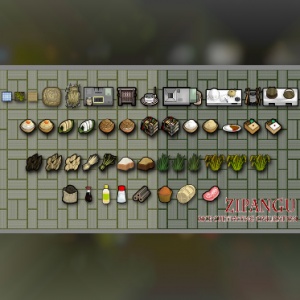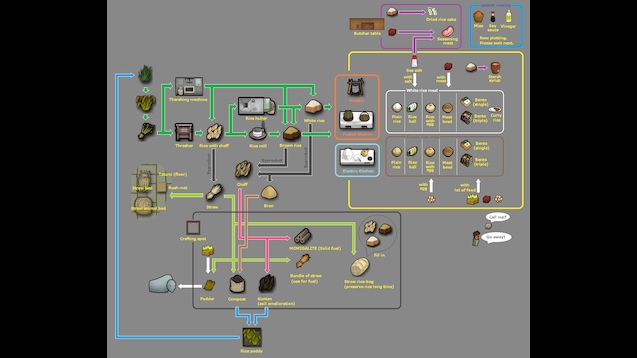Difference between revisions of "Zipangu (Rice cultivation civilization) (A17-mod)"
Jump to navigation
Jump to search
m (→Food (Meals)) |
m (→Food (Meals)) |
||
| Line 16: | Line 16: | ||
***** '''Natural salt:''' (requires nothing) Natural salt made by boiling water containing salt and evaporating moisture. One cooking session produces 10 units. (Market value: $10.00 / Mass: 0.03kg) | ***** '''Natural salt:''' (requires nothing) Natural salt made by boiling water containing salt and evaporating moisture. One cooking session produces 10 units. (Market value: $10.00 / Mass: 0.03kg) | ||
***** '''Onigiris:''' (''Can be eating without a table'') (20 Rice + 1 salt) Rice balls with salty taste to be eaten anywhere. (Market value: $20.00 / Mass: 0.44% / Nutrition: 0.9) | ***** '''Onigiris:''' (''Can be eating without a table'') (20 Rice + 1 salt) Rice balls with salty taste to be eaten anywhere. (Market value: $20.00 / Mass: 0.44% / Nutrition: 0.9) | ||
| − | ***** '''Gyudon:''' (10 rice + | + | ***** '''Gyudon:''' (10 rice + 20 meat / req cooking: 4) A bowl of plenty of meat on rice. (Market value: $20.00 / Mass: 0.44kg / Nutrition: 1.2) |
Revision as of 12:20, 29 December 2018
This Mod adds the following elements:
- Add rice crop and production chains.
- Make various things using by-products, generated during the manufacturing process.
- Make money by selling straw rice bags and other special products.
- Test stage: Make cooking realistic by adding seasoning.
Food (Meals)
- Japonica rice grows in 4 days as opposed to vanilla rice which grows in 3 days.
- The harvest yields "Inaho" (inedible) which must be threshed with the "Threshing machine" to separate "Momi" (food) from "Straw" (material).
- The Momi is Rice with shells and cannot be eaten yet. You will then need a "Rice stone slurry" to separate "Brown rice" (food) from "Outer hull" (various uses).
- Brown rice can be cooked with three different production benches: "Messtin", "Iron pot" and "Rice cooker". You can use the Messtin to produce: Natural salt, Rice syrup, simple meal and four other dishes that each have pair for white and brown rice, being: Gohan, TKG, Gyudon and Onigiri.
- Natural salt: (requires nothing) Natural salt made by boiling water containing salt and evaporating moisture. One cooking session produces 10 units. (Market value: $10.00 / Mass: 0.03kg)
- Onigiris: (Can be eating without a table) (20 Rice + 1 salt) Rice balls with salty taste to be eaten anywhere. (Market value: $20.00 / Mass: 0.44% / Nutrition: 0.9)
- Gyudon: (10 rice + 20 meat / req cooking: 4) A bowl of plenty of meat on rice. (Market value: $20.00 / Mass: 0.44kg / Nutrition: 1.2)
- Brown rice can be cooked with three different production benches: "Messtin", "Iron pot" and "Rice cooker". You can use the Messtin to produce: Natural salt, Rice syrup, simple meal and four other dishes that each have pair for white and brown rice, being: Gohan, TKG, Gyudon and Onigiri.
- The Momi is Rice with shells and cannot be eaten yet. You will then need a "Rice stone slurry" to separate "Brown rice" (food) from "Outer hull" (various uses).
- The harvest yields "Inaho" (inedible) which must be threshed with the "Threshing machine" to separate "Momi" (food) from "Straw" (material).
- The Butcher table can be used to make Freeze mochi: (100 rice) Nochi that can be stored for a long time. It can be eaten raw but also cooked. (Market value: $6.00 / Mass: 0.03kg / Nutrition: 0.2)
- The Brazier (30 Granite blocks) can be used to cook:
- Grilled mochi:
- Three colored dumplings:
- Vinegar mochi: (2 Freeze mochi + 1 Vinegar) Mochi with vinegar and grated Japanese radish. Local cuisine in Kyushu area. (Market value: $30.00 / Mass: 0.44% / Nutrition: 0.5)
- Isobe mochi:
- Gohei mochi:
Weaponry
- Japanese Bow: A bow that improved the Great bow and raised its power (Damage:20) and range (35).
- Naginata (melee): A long stick attached to a sword and improved. It looks like a glaive and has a very long reach.
- Katana blade: It is a sword handed down in the East. Compared with Longsword, it takes many time and effort to make it, but it has high power (damage:26) (cool down:3.00s).
Blacksmith artisan
- Jumonji spear:
- Odochi blade:
Apparel
Most items require hay or cloth but cannot use animal furs. Research in Blacksmith Apprentice.
- Sugekasa: (50 hay) Straw woven kasa (hat), was worn by samurais, ninjas, monks, ronins, traders and farmers in older-eastern-world, can be used to shelter from the sunshine, rain falls, even snowy. (Market value: $124.80 / Mass: 0.14kg / Covers: Head, left ear, right ear. / Armor blunt: 3.3% / Armor sharp: 3.3% / Insulation cold: -5.3C / Plant harvest yield: +5% / Plant work speed: +5%)
- Tengai: (50 hay) A fully covered helmet, woven by straw. Has religious means. However, when you wear it, your face is out of sight, so it gives others a creepy feeling. (Market value: $83.20 / Mass: 0.14kg / Covers: Head, left eye, right eye, left ear, right ear, nose, jaw. / Armor blunt: 4.3% / Armor sharp: 4.3% / Insulation cold: -6.3C / Psychic sensitivity: -20% / Shooting accuracy: -5.0% / Social chat impact: -10%)
- Straw hat:(50 hay) A hat knitted with straw. It is used as sunshade during farm work. (Market value: $83.20 / Mass: 0.14kg / Covers: Head, left ear, right ear. / Armor blunt: 2.6% / Armor sharp: 2.6% / Insulation heat: +4.5C / Plant harvest yield: +5% / Plant work speed: +5%)
- Samuerai clothes: (100 fur) Clothing worn by the Samurai. Because Samurai spirit resides, you can get protection during the melee battle. (Market value: $270.00 / Mass: 0.5kg / Covers: Torso, left shoulder, left arm, right shoulder, right arm, left leg, right leg. / Armor blunt: 18% / Armor sharp: 9% / Insulation cold: -8C / Insulation heat: +8C / Melee dodge chance: 20% / Move speed: +0.23c/s / Melee hit chance: +20%)
- Straw rain cape: (100 hay) Japanese name Mino. A raincoat made of straw, it can also be used as armor while hunting. They were quite common in olden China, Japan, Vietnam and Korea. (Market value: $63.00 / Mass: 2.20kg / Covers: Torso, left shoulder, left arm, right shoulder, right arm, left leg, right leg. / Armor blunt: 2.1% / Armor sharp: 4.9% / Insulation cold: -12C / Insulation heat: +12C / Move speed: -0.03c/s)
- Haori coat: (?) A coat suitable for cold winter. Because it can be used as a formal dress, it is useful for important hospitality as well. (Market value: $330.00 / Mass: 3.80kg / Covers: Torso, left shoulder, left arm, right shoulder, right arm. / Armor blunt: 3% / Armor sharp: 3% / Insulation cold: -40C / Insulation heat: -3.0C / Move speed: -0.05c/s / Recruit prisoner chance: +2.50% / Trade price improvement: +2.50%)
- Ninja clothes: (100 fur) Clothes used for spying and scouting. Moving quickly, you can raid them. (Market value: $215.00 / Mass: 0.50kg / Covers: Torso, left shoulder, left arm, right shoulder, right arm. / Armor blunt: 7.7% / Armor sharp: 7.7% / Insulation cold: -7.2C / Insulation heat: + 7.2C / Move speed: 0.46c/s)
- Dogi: (75 fur) The clothes worn by the martial Taoists of Japan. The lightweight design makes this outfit very convenient and flexible for close combat. (Market value: / Mass: 0.50kg / Covers: Torso, left shoulder, left arm, right shoulder, right arm. / Armor blunt: 8.8% / Armor electric: 11.7% / Armor heat: 38.9%/ Armor sharp: 24.1%/ Insulation cold: -9.9C / Insulation heat: +2.5C / Move dodge chance: 10% / Move speed: +.010 c/s / Mental break shed hold: -5% / Melee hit chance: +10%)
- Asigaru armor: (80 steel + 20 cloth + 10 wood) Armor that (Asigaru) soldier wears. Easy-to-move ingenuity has been given so that any situation can be dealt with. (Market value: $335.00 / Mass: 4.00kg / Covers: Torso, left shoulder, left arm, right shoulder, right arm, left leg, right leg. / Armor blunt: 33% / Armor heat: 11% / Armor sharp: 66% / Insulation cold: -10.5C / Insulation heat: +10.5C / Melee dodge chance: +10% / Move speed: +0.23 c/s / Melee hit chance: +10%)
Blacksmith artisan
- Asigaru armor:
- Jingasa helmet:

